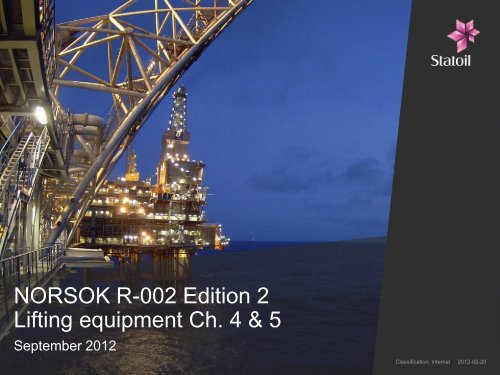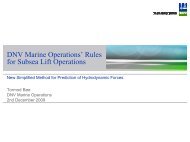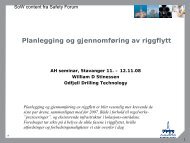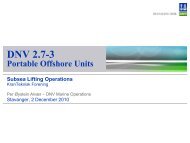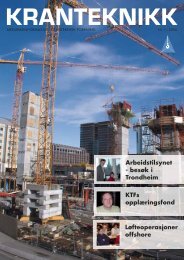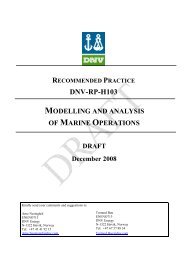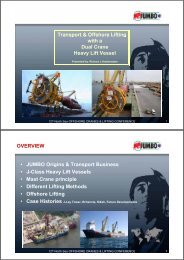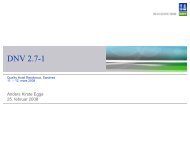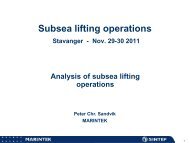NORSOK R-002 Rev. 2
NORSOK R-002 Rev. 2
NORSOK R-002 Rev. 2
- No tags were found...
Create successful ePaper yourself
Turn your PDF publications into a flip-book with our unique Google optimized e-Paper software.
<strong>NORSOK</strong> R-<strong>002</strong> Edition 2Lifting equipment Ch. 4 & 5September 2012Classification: Internal 2012-02-20
Comparison with harmonized standardsR-<strong>002</strong> Edition 24 General safety requirementsMachine safetystandards type:A5 Common requirementsBCAnnexes3Classification: Internal 2012-02-20
Extract from introduction:The requirements of this <strong>NORSOK</strong> standard are given in clause 4, clause 5 and inthe annexes. The combination of all these requirements forms the technical basisthe lifting equipment has to comply with. In case of conflict between similar, but notidentical requirements, the requirements of the annexes prevail over the commonrequirements of clause 5, which in turn prevails over the safety requirements ofclause 4. However, this general rule may only be waived if the manufacturer makesuse of a recognised solution and documents by means of a risk assessment that saidsolution gives an equal or better safety level than the conflicting requirement.Technical basis:4 5 Annex“In case ofconflict betweensimilar, but notidenticalrequirements”:1st2nd3rdAnnex54Condition: Recognised solution4Classification: Internal 2012-02-20
<strong>NORSOK</strong> R-<strong>002</strong>, 4.1 Safety (1)• Lifting equipment shall be designed,fabricated, tested, installed andmaintained in such a way to reduceand minimise risks to humans, theenvironment and material assets.RiskHarmExtended harm= combination of probability of harm and severity of harm= physical injury or damage to health= damage to material assets or the environment6Classification: Internal 2012-02-20
<strong>NORSOK</strong> R-<strong>002</strong>, 4.1 Safety (3)• The lifting equipment shall be designed such that nosingle technical failure results in an unacceptable risk.8Classification: Internal 2012-02-20
4.2 Fitness for use (1)Design:• Simplicity• Comprehensibility• Maintainability• Recognisability9Classification: Internal 2012-02-20
4.2 Fitness for use (2)Selection:• Specific conditions at theworkplace• The work itself• Any risk that may ariseduring the work10Classification: Internal 2012-02-20
4.3 Reliability and availabilityLifting equipment shall be designed and constructed using well-provencomponents and safety principles to ensure reliability by withstanding• The operating stresses and loadings• The environmental influences• Other relevant influencesReliability = ability to perform andmaintain the required functionAvailability = ability to functionIn case of conflict:1. Safety2. Reliability3. Availability11Classification: Internal 2012-02-20
4.4 Principle of safety integration“Harm”:“Extended harm:”VibrationsElectricalhazards12Classification: Internal 2012-02-20
4.5 Inherently safe design measures• Fit for use• Reliable, well proven• Strength• Stability• Fail-safe• Redundant• Interlock• Ergonomic design• Etc.13Classification: Internal 2012-02-20
4.6 Safeguarding and complementaryprotective measures• Guards• Locking devices• Motion limiters, buffers• Rated capasity indictator• Rated capasity limiters• Overload protection devices• Alarms• Anti collision• Safe access and escape• Etc.14Classification: Internal 2012-02-20
4.7 Information for use• Text• Words• Signs• Pictograms• Signals• Symbols• Colors• Sounds, etc.15Classification: Internal 2012-02-20
4.8 Strength proportionThe strength elements (structural andmechanical) of lifting equipment shallbe designed such that theconsequences of accidentaloverloading or unexpected loadconditions which causes break downare known and minimised.This requirement does not apply forlifting accessories and portable units.For cranes this requirement may beachieved by ensuring that the firstelement to fail is not the foundation orany other element which is essentialfor the structural integrity of the entirecrane.16Classification: Internal 2012-02-20
4.9 Maintenance• Design for easy and efficientmaintenance• Access for maintenance• Maintenance priority:1. Safety2. Reliability3. AvailabilityAll lifting equipmentComplex lifting appliancesRisk assessment &Maintenance programComponent level e.g.Reliability Centered Maintenance17Classification: Internal 2012-02-20
4.10 Quality management system• ISO 9001 or equivalent• Continuous improvement18Classification: Internal 2012-02-20
4.11 Risk assessmentFromEN ISO 1210019Classification: Internal 2012-02-20
Risks before riskreductionRisks after inherentlysafe designmeasuresRisks aftersafeguarding/protective measuresRisks afterinformationfor use4.12 Risk reductionShall comprise all possibilities to reduce the risk by using the 3 step method:1. Inherently safe design measures2. Safeguarding and possible complementary protective measures3. Information for use1.2.3.Residual risks to behandled by the user20Classification: Internal 2012-02-20
Internal verificationNotified body, if applicableEnterprice of competence4.13 Documentation of risk assessment / 4.14 VerificationTechnicalconstruction file(5.25)Riskassessmentreport3 rd partyverification,DNVOSS-308 oreq.Use4.15 Qualification of new technology ?21Classification: Internal 2012-02-20
5 Common requirements5.1 Suitability5.2 Materials and products22Classification: Internal 2012-02-20
5.3 Fire and explosionSome standardsreferred to:• EN 13463• <strong>NORSOK</strong> S-001• EN 13478• ISO 7010• IEC 60079 series• EN 1127-1• IEC 61892• <strong>NORSOK</strong> S-<strong>002</strong>• ISO 13702“All types of lifting appliances, fixed, mobile or temporary,electrical or non-electrical, installed or used in hazardousareas, shall comply with ATEX requirements, i.e. Zone 0,Zone 1 or Zone 2”.“Electrotechnical equipment mounted externally(exposed to potential explosive atmosphere) on liftingappliances located in non-hazardous areas, shall as aminimum be classified for use in hazardous area Zone 2,see <strong>NORSOK</strong> S-<strong>002</strong>. Crane boom movements mayrequire Zone 1 equipment”.“Lifting appliances which represent a hazard if operatedin an explosive atmosphere, shall be equipped with anautomatic shut-down system which is activated uponconfirmed gas detection in the crane ventilation systemor in the combustion air inlet, without delay, see<strong>NORSOK</strong> S-001”.23Classification: Internal 2012-02-20
5.4 ErgonomicsTopics covered:• Operator position• Escape and access• Marking• Illumination• Unexpected start-up• Guards• Crushing hazard• Falling objects• Mechanical vibration and shock• Handling and transport facilities• Hot surfaces24Classification: Internal 2012-02-20
5.5 Environmental conditions and 5.6 Operational loadsOperational parameters such as:• Temperatures• Atmosphere• Radiation• Wind• Waves• Sea induced motions and inclinations• Operational loadsthat need to be communicated in time betweenthe manufacturer, the supplier and the end user25Classification: Internal 2012-02-20
5.7 Strength and stability – structureThe strength and stability design of liftingequipment shall be made in accordance withrecognised international standards anddesign codes.The following standards should be used:• NS-EN 13001-1• NS-EN 13001-2The following technical specifications shouldbe used:• CEN/TS 13001-3-1• CEN/TS 13001-3-2• prCEN/TS 13001-3-3• prCEN/TS 13001-3-4For fatigue design of steel structuresreference is made to DNV RP-C203.26Classification: Internal 2012-02-20
5.7 Strength and stability – mechanismsMechanisms are typically motors, brakes,gears, transmissions and similar components.The following standards should be used:• FEM 1.001 Booklet 2• FEM 1.001 Booklet 4• FEM 1.001 Booklet 7• EN 13135-25.8 Strength and stability - Classification27Classification: Internal 2012-02-20
5.9 High risk applicationsLifting equipment intended to be used for the following high risk applications represent anincreased severity of possible harm or extended harm in case of failure:a) Lifting of loads, moving the appliance or partsof it, e.g. the boom, (with or without load)over pressurized or critical equipment, seeAnnex B.3.3b) Lifting of personnelc) Lifting of certain loads that may representsevere consequences, such as e.g.explosives, flammables, dangerouschemicals or pressurised equipmentAs a general rule, the risk coefficient for lifting of persons by the use of lifting appliances shallbe taken as 1.5.Other requirements for the high risk applications are stated in the annexes.Annex K (informative) contain a possible method and applicable means to be considered.28Classification: Internal 2012-02-20
5.10 Power systemsElectrical installations• <strong>NORSOK</strong> E-001(supplies)• IEC 61892• IEC 60034 (motors)Combustion engines• EN 1679-1• EN 1834-1• <strong>NORSOK</strong> R-001Clause 5.529Classification: Internal 2012-02-20
5.11 Electrotechnical / 5.12 Non-electrotechnical equipmentElectrotechnical equipmentEN 13135-1IEC 60204-1IEC 60204-32Non - electrotechnicalequipmentEN 13135-2Minimum requirements for protection againstwater ingress and dust penetration to enclosuresshall be as follows:For indoor located equipment:o Grade IP44 according to IEC 60529For outdoor located equipment:o Grade IP56 according to IEC 6052930Classification: Internal 2012-02-20
5.13 Controls, control stations and control systemsSafety related parts of control systems for complex lifting appliancesshall be in accordance with ISO 13849-1. Unless otherwise stated in this<strong>NORSOK</strong> standard or references made in the annexes, the requiredperformance levels (PLr) for safety related parts of control systems shallbe in accordance with Table 1.For definition of symbols, see ISO 13849-1.Table 1 — Safety functions – required performance levelsEmergencystopSafety functions(hazard of malfunction)SeverityFrequency/time ofexposurePossibility ofavoiding thehazardPLrS2 F1 P2 dLimiters S2 F1 P1 c31Classification: Internal 2012-02-20
5.14 Limiting and indicating devicesLimiting and indicating deviceson lifting appliances shall be inaccordance with EN 12077-2.Visual danger signals shall bein accordance with EN 842.32Classification: Internal 2012-02-20
5.15 Emergency systemsEmergency lowering system required for power operated liftingappliances for suspended loads• Positioned to give a clear view to the load• “hold to run” function• Controlled lowering• Simple to operate• Available without undue delay (15min to land the load)• Clear and unambigous operation procedureEmergency operation system (EOS) required for lifting appliances for thelifting of persons• Move the load in any direction• Secondary independent power supply system• Secondary independent control system• Simple to operate, one motion at the time• 10% speed• Separate emergency stop33Classification: Internal 2012-02-20
5.16 Communication• Cranes and enclosed control stations: Permanentlyinstalled telephone system• Lifting appliance with enclosed control stations:Permanently installed UHF/VHF radio facilities with“handsfree” send/receive function• Lifting appliances with an enclosed control station shall befitted with an external loadspeaker/alarm horn that can beoperated “handsfree”.34Classification: Internal 2012-02-20
5.17 Pneumatics & 5.18 HydraulicsPneumatics:EN ISO 4414Hydraulics:EN ISO 4413• The hydraulic system should be fitted with metallic tube connections for fluid power withelastomeric sealing rings in accordance with ISO 8434 or DIN 2353 combined with hydraulicpipes with cold formed tube ends.• Flexible hoses shall not be used between any load holding valves and hydraulic motors orcylinders.• <strong>NORSOK</strong> standard specifications for piping and pipe fittings for process plants and instrumenttubing shall not be used for lifting appliances.35Classification: Internal 2012-02-20
5.19 EMC & 5.20 Exhaust and noiseEMC:IEC 61000-6-2 (Immunity) and IEC 61000-6-4 (Emission)Exhaust from combustion engines: Directive 97/68/EC as amendedNoise: Minimum noise emission acc. to ISO/TR 11688-1, ISO/TR11688-2 and <strong>NORSOK</strong> S-<strong>002</strong> Annex A36Classification: Internal 2012-02-20
5.21 Utility systemsSightLifting appliances which have an enclosed control station shall have permanentmeans for window cleaning operated from inside the control station. In additionaccess means shall be provided for replacement of windshield wipers and manualcleaning of the windows from the outside.VentilationIndoor climate of lifting appliances shall be in accordance with <strong>NORSOK</strong> S-<strong>002</strong>, 5.7.Utility suppliesLifting appliances shall have permanent arrangements for utility supplies (e.g. water,fuel, service air and electrical connections), as applicable. Details to be agreed upon.Lifting appliances containing fuel, oil, grease etc. which represent a hazard to theenvironment, shall have permanent arrangements for enclosed drainage to tank.37Classification: Internal 2012-02-20
5.22 Fabrication 5.23 Installation and assemblyLifting appliances shall be fabricated,installed and assembled in accordance withDNV Standard for certification of liftingappliances No. 2.22, Ch.2, Section 2Materials and fabrication. This include e.g.• material selection,• material certificates,• material quality,• welding,• forming (hot or cold),• inspection and testing.For installation and assembly relevant partsof <strong>NORSOK</strong> Z-007 also applies.38Classification: Internal 2012-02-20
5.24 Corrosion protection, Surface preparation,Protective coating and Bolting• Due consideration to risk of corrosion when selecting materials and materialcombinations• Surface preparation and protective coating shall be in accordance with <strong>NORSOK</strong>M-501 and/or ISO 12944-1.• Corrosion resistant steel shall be used for external bolting of 10 mm diameter andsmaller.• Larger bolts shall normally be hot-dip galvanised low alloy steel. If other qualitiesare used, special corrosion protection measures shall be applied, e.g. protectedcups grease filled.• Bolt assemblies that are essential to mechanical safety, shall be in accordance withISO 898-1 and DNV Standard for certification of lifting appliances, No.2.22, Ch.2,Sec. 2, C200 and D400.39Classification: Internal 2012-02-20
5.25 Technical construction file• A technical construction file shall be compiled by the manufacturer of liftingequipment.• The technical construction file shall address all requirements of this <strong>NORSOK</strong>standard, as applicable.• The technical construction file shall be prepared and presented in such detail that athird party is able to perform a verification of the product according to therequirements of this <strong>NORSOK</strong> standard, without supplementary information.40Classification: Internal 2012-02-20
5.25 Technical construction file, continuedThe technical file shall contain, as a minimum,• unique identification details of the lifting equipment,• design specification including design parameters,• risk assessments including resulting risk reduction measures and residual risk level,• applicable requirements for the lifting appliance,• standards and codes used,• technical information, such as drawings, diagrams, calculations, test reports etc.,• fabrication documentation, e.g. material certificates, fabrication procedures, weldingdocumentation etc.,• verification reports,• formal statements, declarations and certificates,• instructions for use, including inspection and maintenance instructions, including wear andtear tolerances, non destructive examination (NDE) programmes, if applicable.41Classification: Internal 2012-02-20
5.25. Instruction for use• The instruction for use shall be made available to the enduser.• The instruction for use of lifting appliances shall be inaccordance with EN 12644-1.• The instruction for use of lifting accessories shall be inaccordance with EN 13155, 7.1.• The maintenance instructions shall include amaintenance programme in accordance with 4.9.• The maintenance instructions shall include information ontraining of operators and maintenance personnel.• In the case of complex lifting appliances, the informationon training of operators and maintenance personnel shalltake into account the local conditions on/at the installationand its location.42Classification: Internal 2012-02-20
Presentation titlePresenters namePresenters titleE-mail address ……@statoil.comTel: +4700000000www.statoil.com43Classification: Internal 2012-02-20


